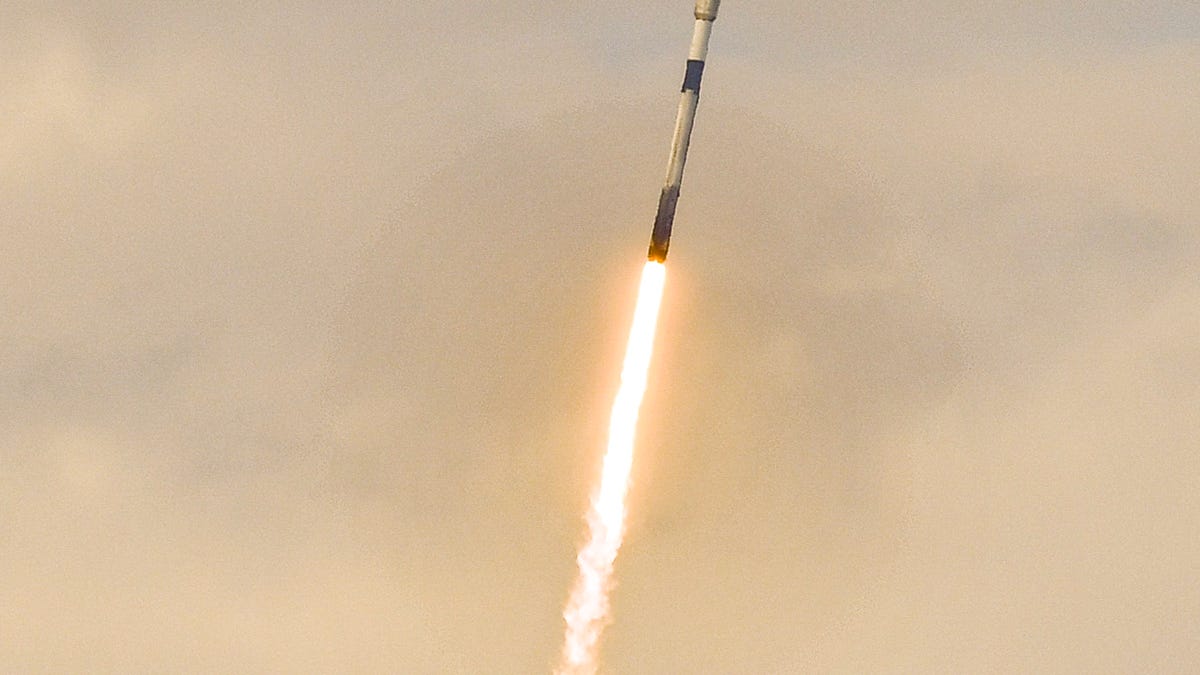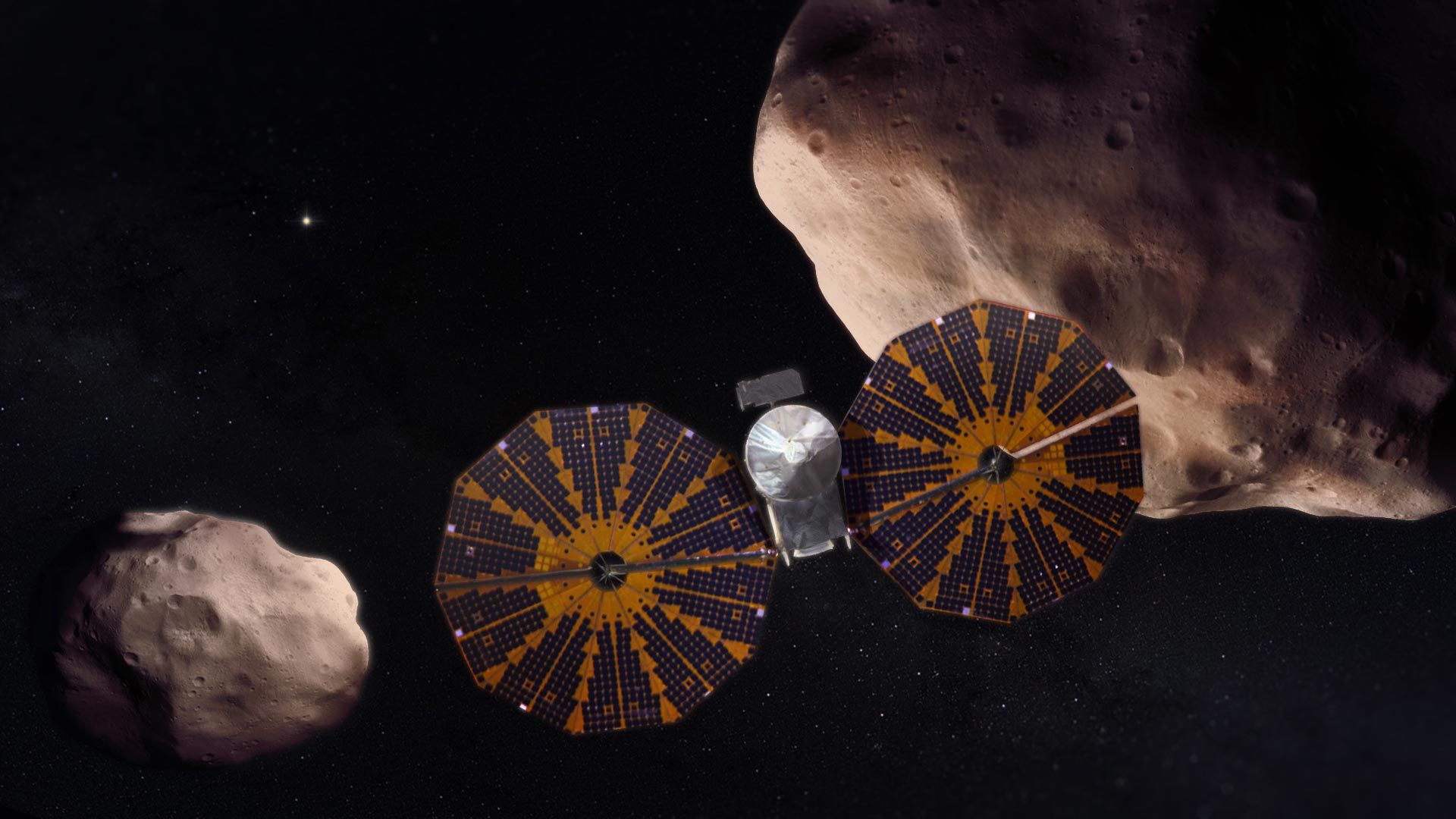ستستكشف لوسي كويكبات طروادة على كوكب المشتري – والتي تُعتبر “حفريات تكوين الكواكب”. الائتمان: مركز جودارد لرحلات الفضاء التابع لناسا
قبل ذلك إطلاق في أكتوبر 2021 ،[{” attribute=””>NASA’s Lucy mission was already on course to break records by visiting more asteroids than any previous mission. Now, the mission can add one more asteroid to the list, after a surprise result from a long-running observation campaign.
Lucy’s science team discovered on March 27 that the smallest of the mission’s Trojan asteroid targets, Polymele, has a satellite of its own. On that day, Polymele was expected to pass in front of a star. This would allow the team to observe the star blink out as the asteroid briefly blocked, or occulted, it. The Lucy team planned to measure the location, size, and shape of Polymele with unprecedented precision while it was outlined by the star behind it. To do so, they spread 26 teams of professional and amateur astronomers across the path where the occultation would be visible.

A graphic showing the observed separation of asteroid Polymele from its discovered satellite. Credit: NASA’s Goddard Space Flight Center
These occultation campaigns have been enormously successful in the past, providing valuable information to the mission on its asteroid targets, but this day would hold a special bonus.
We were thrilled that 14 teams reported observing the star blink out as it passed behind the asteroid. However, as we analyzed the data, we saw that two of the observations were not like the others,” said Marc Buie, Lucy occultation science lead at the Southwest Research Institute, which is headquartered in San Antonio. “Those two observers detected an object around 200 km (about 124 miles) away from Polymele. It had to be a satellite.”

A graphic showing the observed separation of asteroid Polymele from its discovered satellite. Credit: NASA’s Goddard Space Flight Center
Using the occultation data, the scientists determined that this satellite is roughly 3 miles (5 km) in diameter, orbiting Polymele, which is itself around 17 miles (27 km) along its widest axis. The observed distance between the two bodies was approximately 125 miles (200 km).
Following planetary naming conventions, the satellite will not be issued an official name until the team can determine its orbit. As the satellite is too close to Polymele to be clearly seen by Earth-based or Earth-orbiting telescopes – without the help of a fortuitously positioned star – that determination will have to wait until Lucy approaches the asteroid in 2027, unless the team gets lucky with future occultation attempts before then.
At the time of the observation, Polymele was 480 million miles (770 million km) from Earth. Those distances are roughly equivalent to finding a quarter on a sidewalk in Los Angeles – while trying to spot it from a skyscraper thousands of miles away in Manhattan.

Using the occultation data, the team assessed that this satellite is roughly 3 miles (5 km) in diameter, orbiting Polymele, which is itself around 17 miles (27 km) along its widest axis. The observed distance between the two bodies was about 125 miles (200 km). Credit: NASA’s Goddard Space Flight Center
Asteroids hold vital clues to deciphering the history of the solar system – perhaps even the origins of life. Solving these mysteries is a high priority for NASA. The Lucy team originally planned to visit one main belt asteroid and six Trojan asteroids, a previously unexplored population of asteroids that lead and follow Jupiter in its orbit around the Sun. In January of 2021, the team used the Hubble Space Telescope to discover that one of the Trojan asteroids, Eurybates, has a small satellite. Now with this new satellite, Lucy is on track to visit nine asteroids on this remarkable 12-year voyage.
“Lucy’s tagline started out: 12 years, seven asteroids, one spacecraft,” said Lucy program scientist Tom Statler at NASA Headquarters in Washington. “We keep having to change the tagline for this mission, but that’s a good problem to have.”
https://www.youtube.com/watch؟v=H7CA9ZifNRI
في 9 يناير 2020 ، أعلنت بعثة لوسي رسميًا أنها لن تزور سبعة ، بل ثمانية كويكبات. Euripides ، أحد الكويكبات في مدار لوسي ، لديه قمر صناعي صغير. بعد وقت قصير من اكتشاف فريق لوسي للقمر الصناعي ، تحرك هو ويوريبيدس خلف الشمس ، مما منع الفريق من رصده بشكل أكبر. ومع ذلك ، ظهرت الكويكبات من خلف الشمس في يوليو 2020 ، ومنذ ذلك الحين ، تمكن فريق لوسي من تتبع القمر الصناعي مع هابل عدة مرات ، مما سمح بتحديد مدار القمر الصناعي بدقة والحصول على القمر الصناعي الصغير أخيرًا. الاسم الرسمي – Queta.
يقع مقر الباحث الرئيسي في لوسي في بولدر ، كولورادو ، وهو فرع من معهد الأبحاث الجنوبي الغربي ، ومقره في سان أنطونيو ، تكساس. يوفر مركز جودارد لرحلات الفضاء التابع لناسا في جرينبيلت بولاية ماريلاند الإدارة الشاملة للمهمة وهندسة الأنظمة والسلامة وضمان المهمة. قامت شركة لوكهيد مارتن في ليتلتون ، كولورادو ببناء مكوك الفضاء. لوسي هي المهمة الثالثة عشر لبرنامج ديسكفري التابع لناسا. يدير مركز مارشال لرحلات الفضاء التابع لناسا في هانتسفيل بولاية ألاباما برنامج الاكتشاف لمديرية المهام العلمية التابعة للوكالة في واشنطن.

“متعصب للموسيقى. مستكشف متواضع جدا. محلل. متعصب للسفر. مدرس تلفزيوني متطرف. لاعب.”





More Stories
مهمة ستارلينك يوم الثلاثاء من كيب كانافيرال
وصل الدش النيزكي Lyrid إلى ذروته. كيف تشاهد الليلة في ولاية ايوا
لقد وجد العلماء المفتاح لحل لغز اضطرابات الدماغ التنكسية مثل مرض الزهايمر